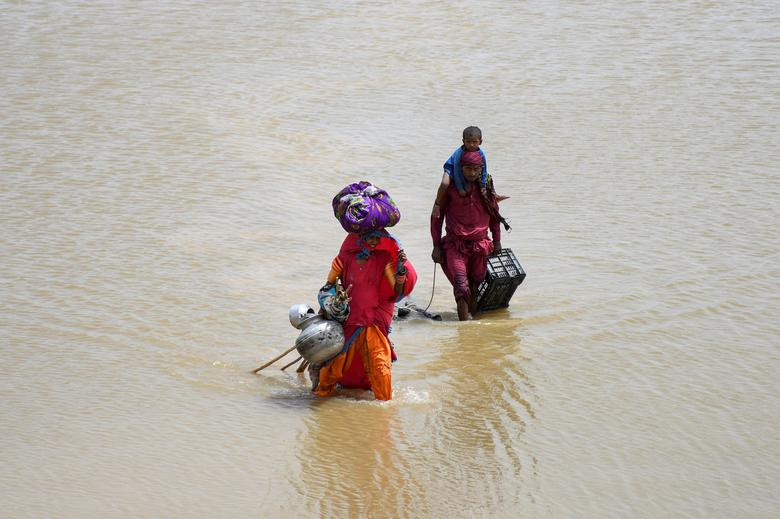
Climate change knows no borders, and Pakistan bears witness to its indiscriminate wrath. The country finds itself at the mercy of a tumultuous climate, where rising temperatures disrupt rainfall patterns and plunge communities into a perpetual cycle of water scarcity and water-related disasters.
Striving for resilience, Pakistan unites with international partners, undertaking bold measures to protect its people, rebuild shattered lives, and forge a sustainable future.
The United Nations and the government of Pakistan co-hosted the Climate Resilient Pakistan conference in Geneva on January 9. The conference aimed to highlight the serious threat posed by climate change, especially in the aftermath of the devastating floods in 2022.
Several countries and development agencies made pledges during the conference, collectively covering over half of the required $16 billion for reconstruction as requested by the Pakistan government.
In mid-June 2022, Pakistan experienced unprecedented monsoon rains, resulting in the worst flooding the country had seen in a decade. According to the National Disaster Management Authority (NDMA), over 33 million people were affected, and more than one million houses were destroyed or damaged.
The floods claimed the lives of at least 1,100 individuals and submerged vast areas spanning several provinces, including Punjab, Khyber Pakhtunkhwa, Balochistan and Sindh.
The NDMA report also highlighted the significant economic crisis caused by the destruction of livestock and agriculture during the 2022 floods. This crisis resulted in severe food shortages, leaving the flood victims vulnerable to malnutrition.
Moreover, the healthcare system was severely affected, with outbreaks of waterborne diseases such as diarrhoea, dengue fever, and malaria. Pregnant women faced additional challenges due to limited access to maternity services and essential menstrual hygiene products in flood-stricken areas.
Despite the immense challenges posed by the floods, the government of Pakistan, with the assistance of the United Nations, provided $245 million in cash support to 2.2 million households. However, the daunting task of reconstruction and rehabilitation still lies ahead.
Collaborating with the UN, the World Bank Group, the Asian Development Bank, and the European Union, Pakistan has prepared a comprehensive post-disaster needs assessment (PDNA).
The assessment estimates that flood damages exceed $14.9 billion, economic losses surpass $15.2 billion, and reconstruction needs over $16.3 billion.
The revival of livelihoods will involve the reconstruction of private housing and public infrastructure, including roads, bridges, schools, and hospitals.
Dr Imran Khalid, the director governance and policy at WWF-Pakistan, emphasised the need for Pakistan to shift its energy reliance from coal to renewable sources.
While Pakistan’s contribution to global CO2 emissions is less than 1%, Dr Imran stressed the importance of proactively reducing dependence on coal and transitioning to alternative energy sources, considering that many other countries are already making the shift.
Dr Sardar Sarfraz, chief meteorologist of the Meteorological Department, explained how westerly winds typically bring thunderstorms and snowfall during the winter season. However, in recent years, the pressure of these winds has extended beyond the usual timeframe, he said.
In May, several parts of the country experienced above-average rainfall, resulting from the prolonged presence of westerly winds. Dr Sarfraz said average temperatures are expected for the first few days of June, with no significant deviations.
The spectre of devastating floods looms large over Pakistan as the NDMA issues a stark warning: there is a 72% likelihood of such catastrophic events occurring this year.
In the face of this alarming prediction, urgent measures must be taken and a robust plan formulated to avert the potential risks and minimise the far-reaching damages.
WWF-Pakistan Director Governance and Policy Dr Imran Khalid emphasised the critical need for a dual approach of climate adaptation and mitigation in Pakistan to address the effects of climate change and avert further disastrous consequences.
Climate adaptation involves implementing actions and policies that reduce the adverse impacts of climate change, while mitigation focuses on measures to curb greenhouse gas emissions, tackling the underlying cause of climate change.
A crucial aspect that demands attention is enhancing the capacity of farmers, empowering them with the necessary knowledge and resources to adapt to changing climatic conditions. Additionally, concerted efforts must be made to develop flood-resistant housing designs that can mitigate flood damages and equip communities with the skills and resources required to cope with heatwaves.
As Pakistan grapples with the projected flood risks, swift and decisive action is imperative. By formulating a comprehensive plan encompassing climate adaptation and mitigation strategies, strengthening community resilience, and addressing governance shortcomings, the nation can reduce vulnerability to devastating floods and pave the way for a more sustainable and secure future.
The time to act for the safety and well-being of present and future generations is now.








1726732405-0/Express-Tribune-Web-(15)1726732405-0-270x192.webp)






1735025557-0/Untitled-(96)1735025557-0-270x192.webp)











COMMENTS
Comments are moderated and generally will be posted if they are on-topic and not abusive.
For more information, please see our Comments FAQ